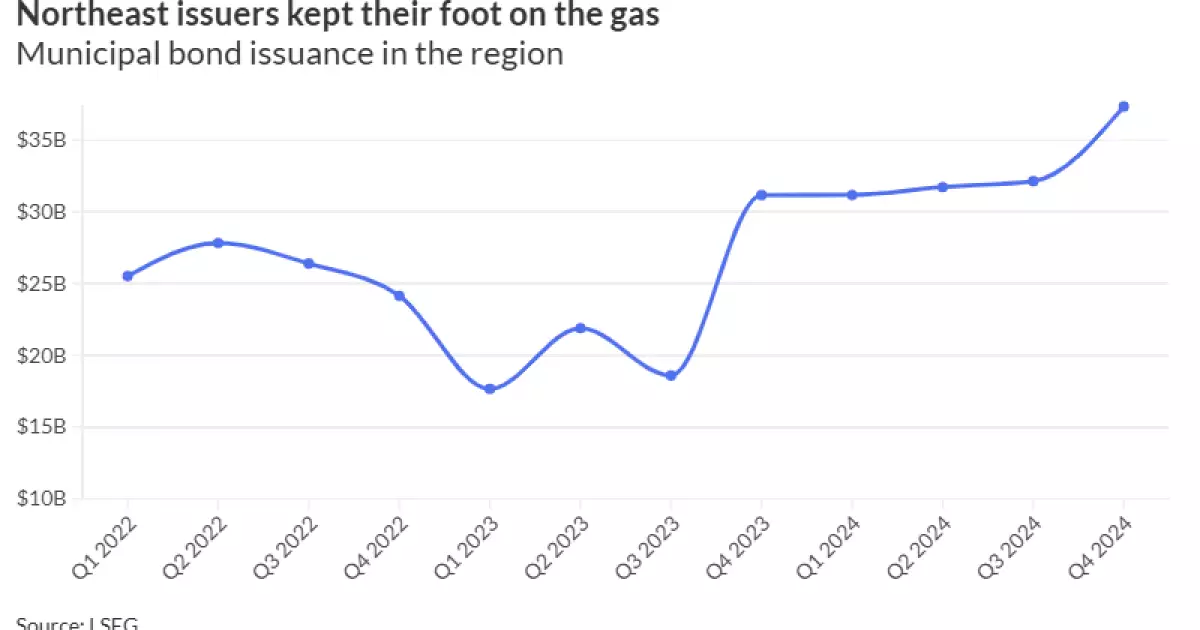The municipal bond market in the Northeast has witnessed an unprecedented surge in issuance during 2024, marking a pivotal moment in regional finance. With a total volume of $132.3 billion—an increase of $43 billion compared to 2023—this year’s performance underscores a significant recovery and growth in investment, with implications that ripple across various sectors. This article delves into the intricacies of these figures, exploring their ramifications for the municipal bond landscape and the states involved.
2024’s bond volume represents a staggering 47.9% increase from the previous year, solidifying the Northeast’s position as the leading region for municipal issuances in the United States. The total eclipses the prior record set in 2020, which stood just shy of $130 billion, showcasing an almost uninterrupted growth trajectory in the current financial climate. The Northeast’s performance stands as a stark contrast to other regions, which have not experienced such robust recovery, highlighting its unique economic dynamics and investor confidence.
Notably, new-money bonds surged by 39% compared to 2023, indicating expanding capital investment aimed at infrastructure and public service enhancements. Alongside this, refunding bonds saw a remarkable 76% increase, suggesting that municipalities are actively seeking to capitalize on favorable interest rates to refinance existing debt, thereby reducing liability costs.
Transportation bonds remained the leading sector, with a 67% increase bringing their total to $28.5 billion. This significant allocation reflects ongoing investments in essential infrastructure—a cornerstone of regional economic development. Following closely, the education sector also saw substantial growth, expanding by 40% to reach $17.5 billion. These figures highlight the prioritization of both physical infrastructure and educational facilities in the Northeastern municipal agenda.
Conversely, the healthcare sector experienced a staggering 198% increase in bond issuance, reaching $10 billion. This growth can be attributed to heightened investments driven by the ongoing need for improved healthcare facilities and responses to public health challenges. However, it is critical to note the sharp decline in bonds issued by higher education institutions, which plummeted by nearly 77%. This contraction suggests a growing hesitance among universities to pursue capital expenditures amid pressing operational challenges, reflecting potential vulnerabilities in academic financing.
In the competitive landscape of municipal bond issuance, New York remains the dominant state, with sales amounting to $58.8 billion, a compelling 39% rise from 2023. Pennsylvania and Massachusetts followed closely, showcasing significant yearly increases of 36% and 67%, respectively. Notably, Maryland has debuted in the top five, nearly doubling its 2023 issuance—an encouraging sign of growth for states outside New York.
Interestingly, states such as New Hampshire and Delaware are notable for exceptional growth rates despite lower overall volumes. New Hampshire’s 251% increase signals a dramatic shift, indicative of aggressive local fiscal strategies positioned to capitalize on potential investment opportunities. Meanwhile, Puerto Rico also demonstrated resilience with nearly 200% growth, which may indicate a stabilizing economic environment after years of distress.
The New York City Transitional Finance Authority stood out as the largest issuer, demonstrating the continuing importance of municipal finance authorities in driving local development efforts. The Dormitory Authority of the State of New York closely followed, reflecting the escalating demand for bond financing in state-funded projects. Equally important is the role of bookrunners and bond counsels, with BofA Securities leading the region in underwriting significant deals.
Emerging trends indicate an increasing competition among advisory firms. Public Resources Advisory Group continues to hold its position as a leader, but firms such as Frasca & Associates are making headway in the rankings, showcasing evolving market dynamics and shifting capacities among financial advisory services.
The record bond issuance in the Northeast during 2024 indicates not just a recovery, but a robust response to the complex demands facing local and state governments. With a diverse array of sectors benefitting from this uptick, the resulting investments have the potential to catalyze further economic growth and improve public infrastructure. As we move forward, it will be critical to monitor how these trends evolve and what implications they may hold for the broader municipal finance landscape in the years to come.

